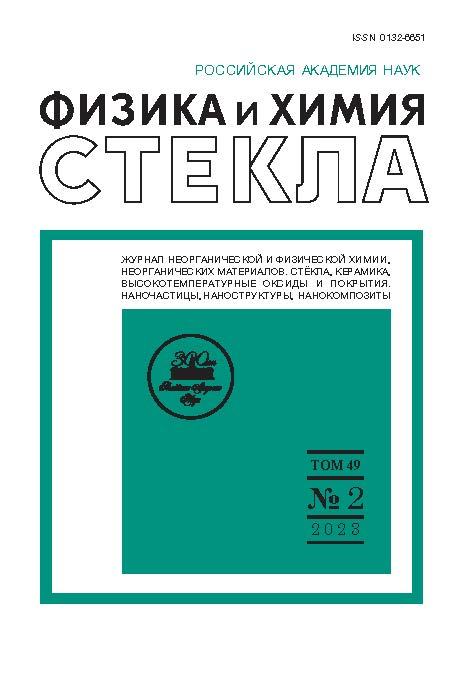Crystallization of Sodium Borosilicate Glass with the Addition of Cr2O3
- Авторлар: Konon M.Y.1, Polyakova I.G.1, Saratovskii A.S.1,2, Danilovich D.P.2, Anfimova I.N.1
-
Мекемелер:
- Grebenshchikov Institute of Silicate Chemistry, Russian Academy of Sciences
- St. Petersburg State Technological Institute (Technical University)
- Шығарылым: Том 49, № 2 (2023)
- Беттер: 204-208
- Бөлім: КРАТКОЕ СООБЩЕНИЕ
- URL: https://medjrf.com/0132-6651/article/view/663259
- DOI: https://doi.org/10.31857/S0132665122600881
- EDN: https://elibrary.ru/NWDSFG
- ID: 663259
Дәйексөз келтіру
Аннотация
Glass composition of 6Na2O 22B2O3·70SiO2·2Cr2O3 is studied by scanning electron microscopy, X‑ray powder diffractometry (XRPD), and differential thermal analysis, depending on the duration of heat treatment at a temperature of 550°C. It is established that during heat treatment for 24–96 h, a phase separation structure with interpenetrating phases is formed in the studied glass, and a crystalline phase of eskolaite—Cr2O3 is also formed. With the maximum heat treatment duration of 96 h, cristobalite is formed in the bulk of the glass, which is accompanied by a decrease in the glass transition temperature of the low-viscosity phase. In this case, the intensity of eskolaite peaks decreases. Cr2O3 and SiO2 crystallize apparently due to the substance of the low-viscosity phase.
Авторлар туралы
M. Konon
Grebenshchikov Institute of Silicate Chemistry, Russian Academy of Sciences
Email: marina-konon@mail.ru
199034, St. Petersburg, Russia
I. Polyakova
Grebenshchikov Institute of Silicate Chemistry, Russian Academy of Sciences
Email: marina-konon@mail.ru
199034, St. Petersburg, Russia
A. Saratovskii
Grebenshchikov Institute of Silicate Chemistry, Russian Academy of Sciences; St. Petersburg State Technological Institute (Technical University)
Email: marina-konon@mail.ru
199034, St. Petersburg, Russia; 190013, St. Petersburg, Russia
D. Danilovich
St. Petersburg State Technological Institute (Technical University)
Email: marina-konon@mail.ru
190013, St. Petersburg, Russia
I. Anfimova
Grebenshchikov Institute of Silicate Chemistry, Russian Academy of Sciences
Хат алмасуға жауапты Автор.
Email: marina-konon@mail.ru
199034, St. Petersburg, Russia
Әдебиет тізімі
- Rao L.N., Rao M.V.S, Tirupataiah Ch., Aruna V., Naga Lakshmi M. Influence of chromium ions on photonic applicability of Na2O–Bi2O3–B2O3–SiO2 glass system // Optics Communications. 2021. V. 480. P. 126496.
- Ebrahimi E., Rezvani M. Optical and structural investigation on sodium borosilicate glasses doped with Cr2O3 // Spectrochimica Acta Part A: Molecular and Biomolecular Spectroscopy. 2018. V. 190. P. 534–538.
- Marzouk S.Y., Gaafar M.S. Ultrasonic study on some borosilicate glasses doped with different transition metal oxides // Solid State Communications. 2007. V. 144. P. 478–483.
- Aktas B., Yalcin S., Dogru K., Uzunoglu Z., Yilmaz D. Structural and radiation shielding properties of chromium oxide doped borosilicate glass // Radiation Physics and Chemistry. 2019. V. 156. P. 144–149.
- Ravi Kumar G., Gopi Krishna M., Rao M.C. Cr3+ doped NaF–ZrO2–B2O3–SiO2 glass ceramic materials for optoelectronic device application // Optik. 2018. V. 173. P. 78–87.
- Polyakova I.G. The Criterion for the Crystallization Ability Assessment as Applied to Borate Glass Powders and Monoliths // Entropy. 2019. V. 21. P. 994–1014.
- Breneman R.C., Halloran J.W. Kinetics of Cristobalite Formation in Sintered Silica // J. Am. Ceram. Soc. 2014. V. 97. № 7. P. 2272–2278.
- Горогоцкая Л.И., Мицюк Б.М. Физико-химические превращения кремнезема в условиях метаморфизма. Наукова Думка, Кте. 1980. 236 с.
- Полякова И.Г., Морозова Э.В. Определение положения купола ликвации методом ДТА на примере натриевоборосиликатных стекол // Физ. и хим. стекла. 1988. Т. 14. № 1. С. 140–143.
- Sandu V., Nicolescu M. S., Kuncser V., Damian R., Sandu E. Magnetic glass-ceramics // J. Advanced Ceramics. 2012. V. 1(2). P. 138–143.











